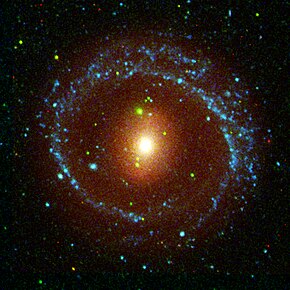| NGC 1291 | |
|---|---|
 This composite image of NGC 1291 is processed primarily from data collected by NASA's Galaxy Evolution Explorer in December 2003. The blue in this image is ultraviolet light captured by GALEX's long wavelength detector, the green is ultraviolet light detected by its short wavelength detector, and the red in the image is visible light courtesy of data from the Cerro Tololo Inter-American Observatory in Chile.[1] | |
| Observation data (J2000 epoch) | |
| Constellation | Eridanus |
| Right ascension | 03h 15m 29.6s[2] |
| Declination | −41° 17′ 25.6″[2] |
| Redshift | 0.002799 (839 ± 2 km/s)[2] |
| Distance | 33 Mly |
| Apparent magnitude (V) | 9.39[2] |
| Absolute magnitude (V) | −21.05[3] |
| Characteristics | |
| Type | (R_1)SB(l)0/a[2] |
| Apparent size (V) | 9′.8 × 8′.1[2] |
| Notable features | inner bar and outer ring structure |
| Other designations | |
| PGC 012209,[2] | |
Preview warning: Page using Template:Infobox galaxy with unknown parameter "image_size"
NGC 1291, also known as NGC 1269,[4] is a ring galaxy with an unusual inner bar and outer ring structure located about 33 million light-years away in the constellation Eridanus.[1] It was discovered by James Dunlop in 1826 and subsequently entered into the New General Catalogue as NGC 1291 by Johan Ludvig Emil Dreyer. John Herschel then observed the same object in 1836 and entered it into the catalog as NGC 1269 without realizing that it was a duplicate.[4] This galaxy was cited as an example of a "transitional galaxy" by NASA's Galaxy Evolution Explorer team in 2007.[5]
- ^ a b Dunbar, Brian (November 22, 2007). Watanabe, Susan (ed.). "NGC 1291". NASA. Archived from the original on March 5, 2016. Retrieved April 1, 2012.
- ^ a b c d e f g "NASA/IPAC Extragalactic Database". Results for NGC 1291. Retrieved October 30, 2009.
- ^ Cite error: The named reference
Hixenbaughwas invoked but never defined (see the help page). - ^ a b "NGC 1291". Capella Observatory. 2005. Retrieved April 1, 2012.
- ^ Dunbar, Brian (November 22, 2007). Watanabe, Susan (ed.). "Portrait of a Galaxy's Life". NASA. Archived from the original on April 6, 2012. Retrieved April 1, 2012.